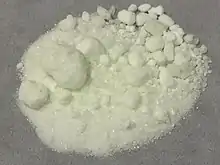 | |
| Names | |
|---|---|
| Other names
Thulium acetate Thulium triacetate | |
| Identifiers | |
3D model (JSmol) |
|
| ChemSpider | |
| ECHA InfoCard | 100.049.369 |
| EC Number |
|
PubChem CID |
|
CompTox Dashboard (EPA) |
|
| |
| |
| Properties | |
| Tm(CH3COO)3 | |
| Appearance | crystals |
| soluble | |
| Hazards | |
| GHS labelling:[1] | |
 | |
| Warning | |
| H315, H319, H335 | |
| P261, P264, P264+P265, P271, P280, P302+P352, P304+P340, P305+P351+P338, P319, P321, P332+P317, P337+P317, P362+P364, P403+P233, P405, P501 | |
Except where otherwise noted, data are given for materials in their standard state (at 25 °C [77 °F], 100 kPa).
Infobox references | |
Thulium(III) acetate is the acetate salt of thulium, with the chemical formula of Tm(CH3COO)3. It can exist in the tetrahydrate or the anhydrous form.[2]
Properties
Thulium(III) acetate reacts with iron acetylacetonate at 300 °C, which can form the hexagonal crystal TmFeO3.[3]
Reacting thulium(III) acetate with trifluoroacetic acid will produce thulium trifluoroacetate:[4]
- Tm(CH3COO)3 + 3 CF3COOH → Tm(CF3COO)3 + 3 CH3COOH
References
- ↑ "Thulium acetate". pubchem.ncbi.nlm.nih.gov.
- ↑ K. I. Petrov, M. G. Zaitseva, L. M. Sukova (1971-08-01). "Spectroscopic study of thulium acetate tetrahydrate single crystals". Journal of Applied Spectroscopy. 15 (2): 1058–1060. Bibcode:1971JApSp..15.1058P. doi:10.1007/BF00607309. ISSN 1573-8647. S2CID 96964200.
{{cite journal}}: CS1 maint: multiple names: authors list (link) - ↑ Masashi Inoue, Toshihiro Nishikawa, Tomohiro Nakamura, Tomoyuki Inui (1997). "Glycothermal Reaction of Rare-Earth Acetate and Iron Acetylacetonate: Formation of Hexagonal ReFeO3". Journal of the American Ceramic Society. 80 (8): 2157–2160. doi:10.1111/j.1151-2916.1997.tb03103.x. ISSN 1551-2916.
{{cite journal}}: CS1 maint: multiple names: authors list (link) - ↑ S. I. Gutnikov, E. V. Karpova, M. A. Zakharov, A. I. Boltalin (2006-04-01). "Thulium(III) trifluoroacetates Tm(CF3COO)3 · 3H2O and Tm2(CF3COO)6 · 2CF3COOH · 3H2O: Synthesis and crystal structure". Russian Journal of Inorganic Chemistry. 51 (4): 541–548. doi:10.1134/S0036023606040061. ISSN 1531-8613. S2CID 101651962.
{{cite journal}}: CS1 maint: multiple names: authors list (link)
External reading
- Mondry, A., & Bukietyńska, K. (2003). The power and limits of the Judd—Ofelt theory: a case of Pr3+ and Tm3+ acetates and dipicolinates. Molecular Physics, 101(7), 923-934.
This article is issued from Wikipedia. The text is licensed under Creative Commons - Attribution - Sharealike. Additional terms may apply for the media files.